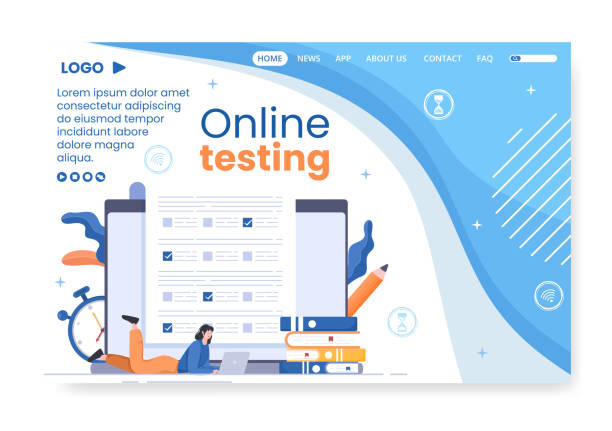Introduction to Responsive Website Design and Its Importance

In today’s world, where users access the internet using various devices such as smartphones, tablets, laptops, and even smart TVs, the importance of responsive website design becomes more apparent than ever. #Responsive_Website_Design is no longer a luxury option, but a necessity for any online business.
This web design approach allows websites to display correctly and provide a seamless user experience (UX) regardless of the user’s device screen size.
The main goal of responsive design is to present the same content with the best possible layout for every screen size.
From an #SEO perspective, Google and other search engines give higher rankings to websites optimized for #mobile. This is because a significant portion of internet searches today are conducted via mobile devices, and search engines aim to provide the best experience to their users.
A properly responsively designed website eliminates the need to maintain multiple separate versions of the site for different devices, which in itself reduces costs and simplifies content management.
Ultimately, investing in responsive website design means investing in the future of your online business and ensuring your website’s accessibility and appeal to every user, anytime, anywhere.
Don’t have a corporate website yet and are missing out on online opportunities? With professional corporate website design by Rasawp,
✅ Double your business credibility
✅ Attract new customers
⚡ Free consultation for your corporate website!
Principles and Foundations of Responsive Design

Responsive website design is based on three key principles: Fluid Grids, Flexible Images, and Media Queries.
Fluid grids mean that website layouts are built using percentages and relative units (such as em or rem) instead of fixed pixels.
This allows page elements to proportionally resize and adjust themselves optimally according to the screen size.
Flexible images are also an integral part of successful responsive design.
This technique involves automatically adjusting image sizes using CSS to prevent them from overflowing or appearing too large on smaller devices.
Typically, using `max-width: 100%;` in CSS ensures that images never exceed their parent container.
The pulsating heart of responsive website design is Media Queries. This CSS3 feature allows developers to apply different styles based on device characteristics such as screen width, height, orientation (portrait or landscape), and even resolution.
For example, you can define rules that, on smaller screens, columns stack instead of appearing side-by-side, or font sizes change.
These principles, together, provide a dynamic and flexible structure for the website, allowing it to function correctly in any environment and deliver an optimal user experience.
This specialized approach is not only technically advanced but also significantly improves website accessibility and usability.
Key Tools and Frameworks in Responsive Design

To effectively implement responsive website design, developers utilize a set of tools and frameworks that facilitate and standardize the process.
One of the most well-known and widely used frameworks is Bootstrap.
Bootstrap is a powerful HTML, CSS, and JavaScript framework that greatly simplifies building responsive websites with its mobile-first grid system, pre-built UI components, and JavaScript plugins.
Due to its excellent documentation and large user community, this framework is a popular choice for various projects.
Another framework that has gained increasing popularity is Tailwind CSS. Unlike Bootstrap, which provides pre-built components, Tailwind CSS is a utility-first framework.
This means that instead of using predefined classes like “btn” or “card”, you use small utility classes to apply specific styles (e.g., “flex”, “pt-4”, “text-center”).
This approach gives developers more flexibility and results in less and more customized CSS.
Beyond these frameworks, other tools like Flexbox and CSS Grid in native CSS also play a vital role in responsive website design.
These features allow for the creation of complex and responsive layouts with less coding.
Below is a table of some popular frameworks for responsive design:
| Framework Name | Main Approach | Advantages | Best For |
|---|---|---|---|
| Bootstrap | Component-based, Mobile-first | High development speed, ready-made components, large community | Projects requiring rapid and standard development |
| Tailwind CSS | Utility-first | High flexibility, optimized CSS generation, lightweight | Projects requiring highly customized design and high performance |
| Foundation | Component-based, Mobile-first | High customizability, compatibility with HTML emails | Complex websites and web applications |
| Bulma | CSS-only, Flexbox-based | CSS-only, easy to learn, modern | Lightweight projects that do not require JavaScript |
Choosing the right framework depends on project requirements, the development team, and design complexities.
Each of these tools, in its own way, contributes to improving the responsive web design process.
User Experience (UX) and User Interface (UI) in Responsive Websites

Responsive website design is not merely limited to visual layout; rather, it is deeply intertwined with the concepts of User Experience (UX) and User Interface (UI).
A good responsive website should not only display well across different screen sizes but also provide a flawless user experience.
This means that navigation should be as easy on mobile as it is on desktop.
Touch Targets should be large enough for mobile users to easily tap them with their fingers, and texts should be legible and understandable without needing to zoom.
For a successful user interface in responsive design, designers should pay attention to the following:
- Content Prioritization: On smaller screens, some content or UI elements may need to be hidden or moved to secondary sections.
This decision should be made based on the content’s importance to the user and the website’s main goals. - Design for Touch: Buttons and links must have enough space to be touched to prevent erroneous clicks.
- Image and Media Optimization: Ensure that images are optimized for fast loading on mobile devices and utilize `srcset` and `
` capabilities to provide different image sizes. - Responsive Fonts: Using relative units like `vw` (viewport width) or `rem` for font sizing helps texts remain legible across various screen sizes.
A responsive website should not only look good but also be functional and easy to use on any device.
This analytical approach helps us focus on the actual user experience beyond just the appearance, making responsive web design more effective and user-friendly.
How much does losing business leads due to an unprofessional website cost you? With professional corporate website design by Rasawp, solve this problem forever!
✅ Increase credibility and trust of potential customers
✅ Easier attraction of new business leads
⚡ Get a free consultation now!
Performance and Speed Optimization in Responsive Design

One of the critical aspects of responsive website design is optimizing performance and loading speed. Given that many mobile users access the internet via slower connections, every millisecond in loading time matters.
A website that doesn’t load quickly, even with excellent responsive design, can lose its users.
Therefore, speed optimization should be considered from the very initial stages of responsive website design.
There are several solutions for improving performance in responsive websites:
- Image Compression: Using appropriate image formats (like WebP) and compressing images without losing quality significantly reduces their size.
Also, use the `srcset` attribute in the `img` tag to provide different image sizes based on screen size. - Lazy Loading: This technique ensures that images and videos are loaded only when the user approaches them, not at the beginning of the page load.
This is especially useful for long pages with a lot of visual content. - CSS and JavaScript Optimization: Minification and Concatenation of CSS and JavaScript files help reduce HTTP requests and file sizes.
Using non-blocking CSS and JS can also improve the loading experience. - Caching: Enabling browser caching for static resources like images, CSS, and JavaScript makes subsequent visits to the website faster.
By implementing these solutions, you can ensure that your responsive website is not only beautiful and functional but also loads quickly and provides an optimal user experience.
This specialized approach and guidance significantly contribute to the stable performance of the website across different devices.
Common Challenges and Solutions in Implementing Responsive Design

Despite numerous advantages, implementing responsive website design is not without its challenges.
One of the first obstacles is the complexity of content management across various screen sizes. What content should be hidden on smaller screens? How can content overflow be prevented? These questions require deep thought and precise planning in the initial design phases.
The solution is to adopt a Content-First approach before coding and carefully evaluate the importance of each piece of content for both mobile and desktop users.
Another challenge relates to images and media.
Ensuring that images display well and load quickly on every device can be difficult.
Using techniques like “responsive images” with `srcset` and `sizes` in HTML, or leveraging CDNs (Content Delivery Networks) to deliver optimized images, can solve this problem.
Testing and debugging responsive websites is also a significant challenge. Given the countless variety of devices and browsers, ensuring proper website functionality across all of them is difficult.
For this purpose, using browser simulator tools, testing on real devices, and conducting regular functional tests are essential.
Performance and speed-related issues, as mentioned earlier, are themselves major challenges in responsive website design.
Clean and optimized coding, reducing HTTP requests, using Lazy Loading, and caching are considered effective solutions in this area.
Ultimately, addressing these challenges requires specialized knowledge, practical experience, and inquisitive thinking to find the best solutions. Success in responsive website design necessitates a comprehensive approach and attention to detail from the project’s inception.
Testing and Validation of Responsive Websites

After implementing responsive website design, the critical stage of testing and validation begins.
Without precise testing, one cannot ensure that the website functions correctly across all devices and browsers. Given the vastness of the device ecosystem, this phase can be challenging, but numerous tools and methods exist to facilitate it.
One of the first steps is to use browser developer tools (such as Chrome DevTools).
These tools allow for simulating various screen sizes and even specific devices.
You can simulate your website in mobile, tablet, and desktop modes to identify initial layout and performance issues.
However, simulators can never replace testing on real devices.
To ensure a complete user experience, you must test the website on several smartphones and tablets with different operating systems (iOS, Android) and varying screen sizes.
This helps you identify issues related to touch, performance, and even font rendering in a real environment.
Online tools such as Google’s Mobile-Friendly Test can also provide valuable information about your website’s mobile compatibility.
These tools not only tell you if your website is mobile-friendly but also identify potential reasons for incompatibility.
Below is a table of commonly used testing tools:
| Tool Name | Type | Main Use | Advantages |
|---|---|---|---|
| Chrome DevTools | Built-in Browser Tool | Device simulation, CSS/JS debugging | Free, easy access, extensive features |
| Mobile-Friendly Test (Google) | Online Tool | Evaluating mobile compatibility from Google’s perspective | Reliable, SEO-relevant, fast |
| BrowserStack / Sauce Labs | Cloud-based Testing Platform | Testing on real devices and browsers (simulated) | Access to thousands of device/browser combinations, test automation |
| Am I Responsive? | Online Tool | Simultaneous display of website in multiple screen sizes | Simple, visual, for quick display |
Continuous and comprehensive testing not only ensures the quality of responsive web design but also helps identify and resolve potential issues before they reach users.
This is an essential component of the development process.
Impact of Responsive Design on SEO and Google Ranking

In the current era, the relationship between responsive website design and Search Engine Optimization (SEO) is very strong and vital.
Google, as the largest search engine in the world, has explicitly stated that it prefers mobile-friendly websites in its mobile search results.
This means that if your website does not have proper responsive design, it may be severely harmed in mobile search rankings.
In 2018, Google officially shifted to “Mobile-First Indexing”.
This means that Google’s crawling bots (Googlebot) primarily examine the mobile version of your website for crawling and indexing.
If your mobile version is not optimized or does not function correctly, this can directly negatively impact your website’s overall ranking in search results, even for searches conducted via desktop.
Furthermore, responsive website design also influences indirect SEO factors.
Responsive websites typically offer a better user experience.
When users are satisfied with your website, the Bounce Rate decreases, and Time on Site increases.
These positive signals indicate to search engines that your website is valuable and can lead to improved rankings.
Finally, a responsive website with a single URL (unlike separate mobile websites with different subdomains or directories) simplifies SEO management.
There’s no need to worry about duplicate content, redirects, or separate link building.
All your links and domain authority point to one location, which helps strengthen the website’s credibility in the eyes of search engines.
This is an analytical and explanatory approach that demonstrates why responsive web design is essential for SEO success today.
Does your company’s website perform as befits your brand? In today’s competitive world, your website is your most important online tool. Rasawp, a specialist in professional corporate website design, helps you to:
✅ Gain the credibility and trust of customers
✅ Convert website visitors into customers
⚡ Get a free consultation now!
The Future of Web Design and the Role of Responsive Websites

Responsive website design, once an emerging trend, has now become an industry standard.
But what role does the future of web design hold for it? With the emergence of new technologies and continuous changes in user behavior, responsive design will remain a fundamental basis for adapting to these developments.
One of the future trends is Progressive Web Apps (PWAs).
PWAs are websites that can offer a user experience similar to native applications, including the ability to install on the device’s home screen, work offline, and send push notifications.
For a PWA to deliver a smooth and efficient experience, it must be designed responsively from the outset to function well on any device.
The emergence of new devices with varying screen sizes and capabilities, such as smartwatches, wearables, and even Virtual/Augmented Reality (VR/AR) interfaces, also creates new challenges and opportunities for responsive website design.
Designers must be ready to adapt websites beyond traditional displays and consider 3D and interactive environments.
Artificial intelligence and machine learning can also play a role in optimizing responsive web design in the future, for instance, in delivering personalized content or automatically adjusting layouts based on user behavior.
This news and entertaining trend indicates that the importance of responsive website design will not only not decrease but will even increase due to the growing need for adaptability to emerging technologies.
Responsive websites will be the backbone of the future web.
Dynamic Content and Its Impact on Responsive Website Design

The discussion of responsive website design extends beyond visual and technical dimensions to the management and presentation of dynamic content.
In a responsive website, content must not only adapt its size to the screen but also its presentation method may change. For example, a complex data table that is easily readable on a desktop may be converted into a scrollable list or a summarized chart on mobile.
This approach raises the question of how to maintain an optimal user experience while dynamic content is fetched from databases or APIs? The solution lies in modular and content-first design.
This means that content elements should be individually manageable and displayable, so they can be arranged or even shown in different ways based on screen size.
Using Content Management Systems (CMS) like WordPress with responsive themes and page builder plugins that offer responsiveness helps developers and site administrators easily manage dynamic content and display it in various environments.
Also, using techniques like “content toggling” or “accordion menus” on mobile to hide some content until the user needs it can help reduce page clutter and improve user experience.
Ultimately, dynamic content on a responsive website must be carefully planned to prevent overwhelming or disorganized information on smaller devices.
Focusing on prioritizing information and providing a consistent user experience, even when content is constantly changing, is one of the key principles in responsive website design for dynamic content.
This explanatory and guidance section highlights the importance of thinking about content alongside design.
Frequently Asked Questions
| Question | Answer |
|---|---|
| What is responsive website design? | Responsive Web Design is an approach that ensures the design and layout of a website adapt and display optimally based on the user’s device screen size (computer, tablet, mobile, etc.). |
| Why is responsive design important? | Its importance stems from the increased use of various devices to access the internet. Responsive design improves user experience (UX), reduces bounce rate, and is also beneficial for SEO. |
| What techniques are used in responsive design? | The main techniques include using Fluid Grids, Flexible Images, and Media Queries in CSS. |
| What does Fluid Grids mean? | Instead of using fixed pixel units, relative units such as percentages or ems are used to define the width and height of elements, making the layout flexible with changing screen sizes. |
| What is the application of Media Queries? | Media Queries allow you to apply different CSS styles based on user device characteristics such as screen width, height, orientation (horizontal or vertical), and resolution. |
And other services of Rasaweb Advertising Agency in the field of advertising
Methods to increase store credibility through classified ads
Investigating the impact of geographical location on ad success
How to properly use product photos in ads
Can video be a suitable alternative to images in ads?
How to prevent customer anxiety in sales ads
And more than hundreds of other services in the field of internet advertising, advertising consultation, and organizational solutions
Internet Advertising | Advertising Strategy | Advertorials
🚀 For your business to soar in the digital world, Rasawp Afarin, with its comprehensive and specialized services including custom website design, SEO, and content marketing, paves your path to growth. With us, experience a powerful and targeted presence in the online space.
📍 Tehran, Mirdamad Street, next to Bank Markazi, Kazeroun Jonoubi Alley, Ramin Alley No. 6



